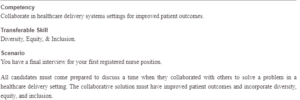Collaborative Problem-Solving in Healthcare- Enhancing Patient Outcomes through Diversity, Equity, and Inclusion
A multidisciplinary team approach to patient care is one example of how collaboration can be used to overcome issues that arise during healthcare delivery. Patients benefit from more comprehensive care when they work with a team that includes a doctor, nurse, social worker, and nutritionist (Matzke et al., 2018). This strategy improves patient outcomes by ensuring that every aspect of treatment is investigated and addressed. Another example of medical collaboration is developing a paradigm for shared decision-making between healthcare providers and patients. This strategy has improved patient outcomes by fostering greater trust and open communication between medical professionals and their patients.
Do you need an unpublished “Collaboration to Improve Outcomes nursing assignment” version? Reach out to us.
Because there are insufficient resources to meet demand, not all patients receive critical medical care, which is a significant issue. Patients’ outcomes may deteriorate if necessary maintenance is not provided on time. The collaborative approach to the problem necessitates the formation of a team of professional medical doctors, nurses, and support staff to collaborate in the delivery of patient care. People from various ethnic and cultural backgrounds comprise the group (Rosenkranz et al., 2021). The team is highly egalitarian because every member contributes equally to the group effort. The inclusiveness of the team is also evident in its members’ collaboration to provide the best possible treatment to the patients, then equality and diversity by forming a diverse, equitable, and inclusive tea by forming a diverse, equitable, and inclusive team. Team members represent various races and cultures, adding to the squad’s diversity. The group is egalitarian because each team member contributes equally to the overall effort. The team may be perceived as inclusive because everyone works together to provide the best possible patient care.
Other Related Post: Nursing Reflective Journal
References
Matzke, G. R., Moczygemba, L. R., Williams, K. J., Czar, M. J., & Lee, W. T. (2018)A pharmacist–physician collaborative care mode impacts patient outcomes and health services utilization.The Bulletin of the American Society of Hospital Pharmacists, 75(14), 1039- 1047.
Rosenkranz, K. M., Arora, T. K., Termuhlen, P. M., Stain, S. C., Misra, S., Dent, D., & Nfonsam, (2021).Why do diversity, equity, and inclusion in medicine matter, and how do we achieve it? Journal of surgical education, 78(4), 1058-1065.
ORDER A PLAGIARISM-FREE PAPER HERE
We’ll write everything from scratch
Question
Competency
Collaborate in healthcare delivery systems settings for improved patient outcomes.
Transferable Skill
Diversity, Equity, & Inclusion.
Scenario
You have a final interview for your first registered nurse position.
All candidates must come prepared to discuss a time when they collaborated with others to solve a problem in a healthcare delivery setting. The collaborative solution must have improved patient outcomes and incorporate diversity, equity, and inclusion.

Collaborative Problem-Solving in Healthcare- Enhancing Patient Outcomes through Diversity, Equity, and Inclusion
To prepare for the interview, you will create notes.
Directions
Select an example that demonstrates collaboration with others to solve a problem in a healthcare delivery setting to improve patient outcomes. The collaborative solution must incorporate diversity, equity, and inclusion.
- Please describe the problem, including the healthcare delivery setting and its impact on patient outcomes.
- Explain the collaborative solution, including the people involved and the improvement in patient outcomes.
- Describe how diversity, equity, and inclusion were incorporated into the collaborative solution.

